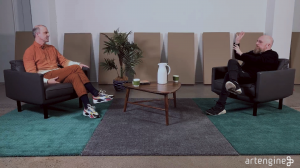Sandra Alfoldy’s artist talk delves into the intricate relationship between craft, technology, tradition, and the evolving discourse surrounding the maker’s hand. With eloquence and depth, she navigates through the complexities of terminology and the shifting paradigms within professional studio practice and popular culture.
Alfoldy deftly unpacks the dichotomy between the glorification of handcrafted authenticity in consumer culture and its diminished significance within professional studio settings. She critically examines the Eurocentric underpinnings of craft and design history, questioning the persistent dominance of European traditions and philosophies.
Drawing parallels between past debates and contemporary concerns, Alfoldy provocatively asks whether the advancement of technology enhances intellect or diminishes sensuality in the creative process. She challenges the audience to contemplate the implications of a global discourse on craftsmanship and the tension between the desire for artisanal quality and the lure of mass-produced affordability.
Ultimately, Alfoldy confronts the existential question of what is at stake in the ongoing dialogue about the role of the maker’s hand. With echoes of historical anxieties about industrialization, she prompts reflection on whether we risk sacrificing artistry in pursuit of efficiency and control. Through her incisive analysis, Alfoldy invites us to reconsider the essence of craft and its enduring relevance in a rapidly changing world.
This presentation was part of the symposium Unhanded. In this panel we ask about the variety of new relationships with materials that emerging with the increasing ubiquitousness of digital technologies. With the increased complexity of tools we wonder how do we learn about materials? How do we get to know them? How do we share this knowledge? We can now know the molecular structure of wood or metal without touching it. Is this a more intimate relationship than working directly with our hands? Does it matter? If the objects coming out of digital and mechanical processes are more removed from our handywork, how might they carry the mark of the machine? Should we be able to read the machine in the material?
It is with very heavy hearts that we acknowledge the untimely passing of Dr. Sandra Alfoldy on February 24, 2019.
NSCAD University invites you to remember and honour Sandra, by helping future students continue her intellectual legacy through the establishment of the Dr. Sandra Alfoldy Memorial Scholarships, in her memory. Your financial support will help students pursue and continue their studies and contribute to and continue work in craft history and media.
Dr. Sandra Alfoldy was a respected scholar in craft history, having received her Ph.D. from Concordia University in 2001, and completing a post-doctoral fellowship at the University of Rochester in 2002. Her research notably focused on the relationship between craft and architecture in post-war Canada, as well as the historical tensions between Canadian studio craft and industrial design. She authored “Crafting Identity: The Development of Professional Fine Craft in Canada” (McGill Queen’s University Press, 2005), edited “Neocraft: Modernity and the Crafts” (NSCAD Press, 2007), and co-edited “Craft, Space and Interior Design: 1855-2005” (Ashgate Press, 2008). These works underscore her significant contribution to the understanding and appreciation of craft in both historical and contemporary contexts.
If technology is used, it is often described as facilitating the maker's vision. So there is an idea that technology is very positive, it helps, but the maker has not lost use of his or her hand.
The idea right from the inception was a really exciting one, so I’m curious to see how it all unfold. So given the title of this morning’s panel, I have decided call my own presentation, talking making, and I just want to do that very briefly. I was really interested in the title of today’s symposium. I’m handed and I had a few questions about that. What does that mean? Is this title the idea of removing the hand from making or is the focus today going to be on how we talk about the hand and its role in the process of making? I like both these ideas. So in my brief 4 minutes, what I’d like to do is just go over both of them. This session that we’re on begins with the question what terms do we use to describe what is done? Right now? I’m researching craft and popular culture, so I’m answering that question from a kind of popular culture perspective. But in my research for the book I’m working on called Craft Washing, I thought, that’s a dangerous title. I found that these terms are most commonly used, so I like jumped right passing handcraft shifted, made by hand, artisanal made with love and small batch. Within professional studio practice, these terms are almost poisonous. You will rarely find these being used in that way. So there are really two types of craft washing going on today, in my opinion. First, I think within studio practice, professional studio practice, if technology is used, it is often described as facilitating the maker’s vision. So there is an idea that technology is very positive, it helps, but the maker has not lost use of his or her hand. Although the hand is rarely foregrounded, it’s the maker’s originality, the creative vision, the thinking that gets the spotlight. On the other hand, within corporations and pop culture, the technology is unacknowledged and the hand crafted. And the idea of crafting with love is what’s emphasized, no matter how ironic. Like I Domino’s Artisan pizza for $7.99. Another question this panel asks is What are the links to European traditions of craft and how do they relate to a new, more broadly inclusive language and I don’t mean to be too negative, but the reality, in my opinion is that still today, the fields of craft and design history and and studies are predominantly Eurocentric.
So how do we discuss this idea of tradition, imitation, inheritance in the processes of making in the 21st century? Does unending reflect an increase in intellect? Is that what we’re after or is an handling a diminishment of sensuality? So I’m curious about that relationship and how do we apply this to a global be a new and inclusive language? I think there’s the rub. We still are applying that. And so that Eurocentric imperative is still there. We haven’t resolved the yearning that we always have to make and own beautifully handcrafted objects that can enhance our lives with the good old desire for cheap, handcrafted items. So I wonder when we talk about the role of the maker’s hand if we’re just shopped at H&M, I just had to buy my teenager back to school. What way I had to pay for it. He bought them. But you know, H&M is where the kids go forever 21 because it’s cheap. They’re not stopping to ask whether or not the makers hands are involved, how much technology is at play here, what’s going on in that relationship where the mindless imitation, the blind tradition, the complacent inheritance in a global discussion. The final question that this panel asks is what is at stake? That’s a big question and not to be overly dramatic, but I think the answer like go to used is everything he wrote in 1797, being worried about the industrial revolution in mass production leading to the death of art, he said, quote, The perfecting of machinery, the refinement of handicraft and factory production bids fair to be the utter downfall of art.

In this conversation Tim Maughan chats with us about digital infrastructure, the role of organized labour in the creative landscape, and the DEL project Artwork_Local404. Join us, as we discuss technology and capitalism, the benefits of organizing, and what form collective action might take. Maughan also talks about how we need to rethink many of the platforms of tools of the digital world as public infrastructure: this may change how we understand what the government could do with them.

Western thought has long assumed a special relationship between vision and knowledge: Seeing is believing. But what about the traffic between sonic experience and ideas? How do inherited beliefs abo(…)